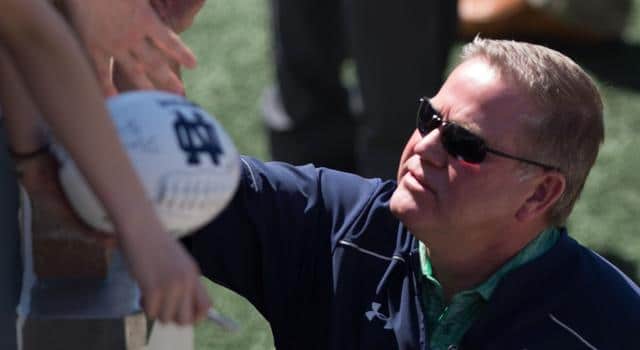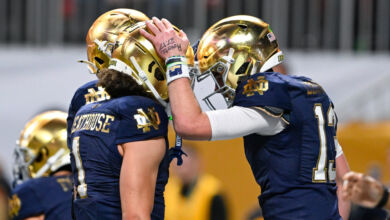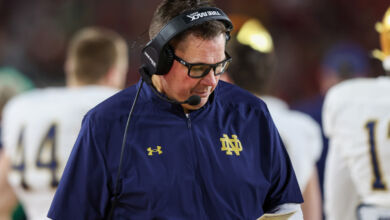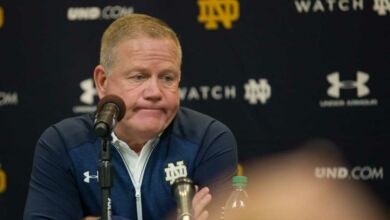

The offseason for college football is usually spent covering inconsequential items like what jersey numbers incoming freshmen will receive or, if it’s really a slow news day, what current NCAA head coach starred in a jeans commercial in the 1980s (hint: he used to coach for Georgia). This year’s major brouhaha came courtesy of Michigan head coach Jim Harbaugh, a man whose penchant for making the news by rubbing people the wrong way led to Newsweek comparing him to Donald Trump. Harbaugh’s push for satellite camps – and his subsequent victory in maintaining them despite angering the SEC – has been the major story in 2016 and will completely overhaul the recruiting landscape.
The satellite camp debate began to surface nationally in 2014 with Penn State’s James Franklin. NCAA rules state coaches cannot host a football camp outside of a 50-mile radius of their campus but, seeing a loophole, Franklin realized there wasn’t anything prohibiting a coach from being a guest at another institution’s camp outside of the 50-mile zone. Franklin exploited the language of the rule to serve as a guest at Georgia State’s camp, a move which allowed a Big Ten program to plant its flag in the heart of SEC recruiting grounds. As incendiary as Franklin’s liberal interpretation of the rule may have been, Harbaugh doused it in kerosene and blew the issue sky high when he attended a camp at the IMG Academy in Florida, a national powerhouse of production for high school recruits. The legality of Harbaugh’s actions was challenged but the NCAA ultimately upheld the existence of satellite camps, a decision that will open the floodgates nationwide as schools seek to not be left behind.
The biggest objection to the existence of satellite camps is the time and cost it will place upon each institution. Last June alone Harbaugh underwent a seven-state satellite camp tour that cost the University of Michigan $211,000, a paltry sum compared to the bill the Wolverines will soon accrue as Harbaugh gears up for 26 satellite camps in 15 different states this summer. And many coaches are simply not thrilled about adding even more to an already packed year-round schedule.
“I’m selfish with my time,” Ole Miss head coach Hugh Freeze said in regard to the rise in prominence of satellite camps. “I’m away from my family enough.”
Satellite camps are all the more wasteful considering the revision of one single NCAA rule would largely negate the need for them. Currently each prospective recruit is allowed five official visits where the hosting university can pay for travel expenses, yet official visits cannot be taken until the fall of a recruit’s senior year. Given recruiting has increased to the point it isn’t outside the norm for middle school students to receive scholarship offers, waiting to commit can cost a recruit a chance at the school of their choice. To combat the antiquated timeline of official visits many recruits chose to take “unofficial” visits to campuses, opting instead to pay out-of-pocket to see as many universities as they can. This, of course, makes a recruit’s ability to visit dependent upon the finances of his family, an unfair burden to those being recruited and a hurdle for Big Ten programs seeking to host the hotbed of talent below the Mason-Dixon line.
The NCAA’s lack of action on updating the rules to allow recruits to take official visits during the spring and summer is what created satellite camps – if a high school prospect is unable to come to you, why not go to them? – and football programs have little choice but to adapt to stay relevant, which could prove problematic for Notre Dame. Head coach Brian Kelly and staff have stayed away from the satellite camp kerfuffle by doubling-down with on-campus events, such as the Irish Invasion.
“We haven’t gotten into satellites because we like to bring kids to our campus,” recruiting coordinator Mike Elston said last month before the NCAA ruled satellite camps to be legal. “In terms of kids knowing what Notre Dame’s about, we’ve got to get them here on campus.”
There is truth in Elston’s words. Notre Dame isn’t for everyone and the only way to truly tell if it’s for you is to visit, an axiom that prompted the following famous words from legendary coach Lou Holtz: “Those who know Notre Dame, no explanation’s necessary. Those won’t don’t, no explanation will suffice.” But how many Southern recruits are willing to postpone their commitment at a school they’re interested in simply to wait until the fall to visit Notre Dame first? If there are recruits that cannot get to Notre Dame, Notre Dame needs to get with the times and get to the recruits.
Fortunately, Notre Dame has tentative plans to be present at satellite camps in Detroit, an area of recruiting focus for defensive line coach Keith Gilmore, and Tampa Bay this summer. But until the NCAA decides to allow recruits to take official visits before the fall, Notre Dame should begin to immediately ramp up its satellite camp production or risk being as outdated as the NCAA’s rulebook.
Scott Janssen is a blogger for the Huffington Post and has authored several nationally-featured articles, including an appearance on MSNBC as a sports contributor. He talks football 24 hours a day, much to the chagrin of his wife and those around him. Scott can be reached at scottjanssenhp@gmail.com or follow him on Twitter.





Great post Pops!
Incredibly well thought out and cogent response. Can’t wait for more.
Keep up the good work.
This is balanced though, by the expansion of payment for parents attending visits, which is a big win for ND. So many 17 year olds may be sold on the flash and glitz of Alabama and OSU, but their parents will know better, and push for substance.
Michigan’s head coach is what he is, an argent, irritating and dis respectable coach. He ruined Stanford’s graduation rate, kicked out of the Forty Niners and so far at Mic. he had dismissed kids who had scholarships , Michigan got just what they deserve. We shall see how long Mic. will put up with his attitudes. As for the camps. Who cares.